In our June 2008 issue we compared Ruger’s then-new LCP 380 with the established Kel-Tec P-3AT, and it seemed to us that Ruger had simply cloned the little Kel-Tec. While the two guns obviously had identical designs, and some of the parts would
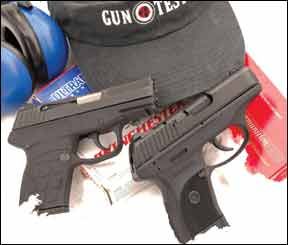
interchange, there were some significant dimensional differences that distinguished the pair. But to us, there was no doubt Ruger had simply copied the Kel-Tec 380’s design with enough changes to avoid legal problems.
Now it appears Ruger has done it again, this time with its LC9 going against the Kel-Tec PF-9, both slim, single-stack, easily concealable DAO 9mm handguns. But now, instead of a $6 difference in price and not much different about the operation of the two 380s, there’s a $110 extra charge for the Ruger 9mm, a third again the cost of the Kel-Tec. As we’ll see, there are some notable differences.
We originally tested the Kel-Tec PF-9 in our November 2007 issue and our Houston test crew had problems with its trigger. As a result the PF-9 got a failing grade. Did Kel-Tec pay attention and change things? Would the brand-new Ruger have similar problems? We took the guns to the range with Black Hills 147-grain subsonic FMJ, Winchester 115-grain truncated-cone BEB, and Ultramax 125-grain round-nose lead ammo. Here’s what we found.
Kel-Tec PF-9 9mm, $333
All business-like flat black, the blued Kel-Tec PF-9 is slim and easily concealable. It was a bit too big for most trouser pockets, but would fit most overcoat pockets. Parkerizing or hard chrome can be had for slightly higher prices. The PF-9 came with one magazine and two types of floorplate. One was flat for better concealment and easier pocketing, and the other had a finger ledge for a better grip. We tried both and much preferred the flat one. The fixed sights gave an excellent picture that we thought could be improved by widening the rear notch. There were three
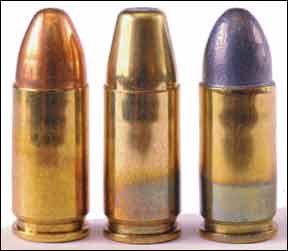
white dots. The rear sight was adjustable for windage, and by shimming for elevation. An Allen screw secured it. Both the front and rear sights were polymer, as was the trigger and, of course, most of the frame.
The integral grips had a coarse checkerboard pattern that provided excellent traction, and the front and rear grip straps had vertical serrations. The magazine release was a steel button that was not easy to hit accidentally, but let the mag come out easily when intentionally pressed. The gun could be fired with the magazine removed, unlike the Ruger.
The PF-9 was smooth all over, with almost no protrusions. The sides of the slide were rounded at the front for easier holstering or pocketing. Everything about the gun was slim or flat. There was no mechanical safety lever, but it had an inner hammer-blocking mechanism. The left side of the gun had a takedown pin that protruded less than a sixteenth of an inch, and a slide stop that stuck out a bit more. The slide stop had a small, neat ledge cast into the frame that protected the underside of the bent-steel stop from catching on clothing, or getting bent from misuse. The rear of the slide had good serrations, easily grasped for chambering a
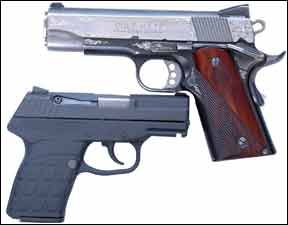
round. There was a rail under the muzzle for a light. Unfortunately, this rail had a slot with sharp edges that could indeed catch on clothing. We would trim the edges with a sharp knife if we owned the gun, something that would take less than a minute. We looked at the Kel-Tec website (www.KeltecWeapons.com) to see if a suitable light was offered for the rail, but there was none.
Takedown is simple. Just clear the gun, lock the slide back and pry out the cross pin. Then remove the magazine and let the slide go forward off the front. The concentric recoil springs are then easily removed and the barrel comes right out. We wondered about the plastic guide rod for the recoil springs, but Ruger copied that exactly. Reassembly of the Kel-Tec requires a trick. You must press down on the barrel to keep it in place while retracting the slide fully. Then it’s simple to reinsert the cross pin, and you’re done.
The mag held seven rounds, and one more in the chamber. With a round in the chamber, pull the long-travel trigger and the gun fires, much like a S&W Centennial snubby. The PF-9’s trigger was the
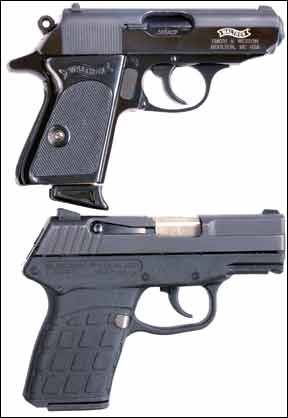
cause of our Houston team giving this gun a failing grade several years ago. Yes, it takes a long pull to get the gun to fire. And we wondered about releasing the trigger far enough to get the next shot. Would we have trouble with rapid fire? We took the gun to the range to find out.
Here in Idaho in 2011 we were unable to repeat the problems documented earlier in Houston. We suspect Kel-Tec paid attention and made whatever corrections were needed, or else our former test gun was a lemon. The so-called “problem” of a long reset to the trigger is still characteristic of the Kel-Tec. If you attempt to fire the gun after only the first of two rather audible clicks on the reset travel, the gun won’t fire. The trigger will not move rearward. Contrary to what the manual says, the hammer is not “dropped” if you fail to let the trigger go fully forward and attempt to press it. The hammer remains cocked until you let the trigger go all the way forward and press it rearward again to fire the gun. There is no need to cycle the slide, as was noted in our previous test, as long as the hammer was cocked by the preceding shot. The hammer remains cocked until it’s dropped by the trigger.
In our testing we came to love the trigger of the Kel-Tec. It always gave us a surprise break during slow fire, and the pull force was a
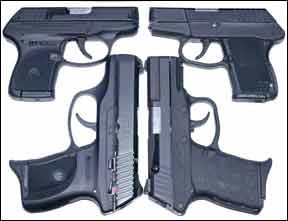
fraction of that of the Ruger. We had no trouble whatsoever with short-stroking the trigger in rapid shooting. In fact, the recoil seemed to blow the gun backwards and our trigger finger forward. We were unaware of the trigger needing to be carefully allowed to go all the way forward. Some of our test crew have long experience with shooting double-action revolvers very fast, and that might have helped too. These DAO guns are not intended to be target guns, and making small groups is not their forte. Instead it’s self defense, and for that a trigger like that on the Kel-Tec is entirely adequate.
Our first test shooting was done with 147-grain Black Hills FMJ, and the recoil was definitely pronounced. The Kel-Tec wanted to shoot high and to the left with that load. Before we changed the sight setting we tried some 115-grain BEB Winchester, and it printed just above the point of aim at 15 yards, exactly where we wanted it. We had not yet shot the Kel-Tec for accuracy, but were very eager to find out how well the gun did in rapid fire, and compare it with the Ruger. We fired several two-shot bursts from
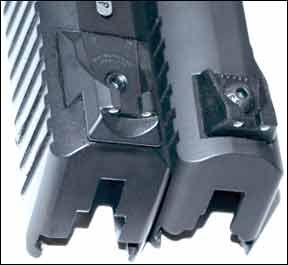
each gun, and immediately noted the Kel-Tec was by far the easier to shoot, had the better trigger pull for such work, and gave us better results. We had no trouble whatsoever with resetting the trigger, no matter how fast we tried to shoot the Kel-Tec.
We essentially had no problems at all with the Kel-Tec PF-9. We had one failure for the slide to lock back on empty with the first magazine-full through it, but that never happened again. Like the P-3AT 380 Kel-Tec, the lower-front edge of the trigger was notably sharp, and it pinched us. We would round it if we owned this gun. The recoil of the heavy-bullet load made the trigger give us a nasty bite on the finger from the flip, no matter how hard we held the gun down. The PF-9 also kicked our palm more sharply than the Ruger, but then, it weighs significantly less, so that is to be expected. The trigger pull was smooth, much more easily controlled in slow fire than the Ruger, and also faster in rapid fire. The impact of the Kel-Tec PF-9 changed more with different weight bullets, so be sure to get it centered with your ammo of choice.
Our Team Said: We came away from the tests really liking the Kel-Tec and not liking the Ruger nearly as much. If we had 50 rounds to shoot at a sitting, we’d choose the Ruger, but for
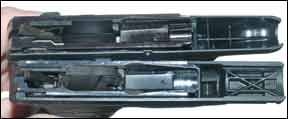
concealed carry and the few rounds one might shoot in a self-defense encounter, there’s no question in our minds. We’d choose the Kel-Tec. We consider it an ‘A’-grade gun from every important standpoint: price, accuracy, reliability, light weight, slim, you name it. We think this is one mighty fine 9mm handgun, but it is not for the recoil-sensitive person.
Ruger LC9 9mm, $443
Our first look at the new Ruger showed us an attractive firearm with several features that the Kel-Tec didn’t have. Whether they are needed is another question. Undoubtedly, they add to the weight of the gun. The empty Ruger weighed 2.5 ounces more than the Kel-Tec, 17.1 vs. 14.6 ounces. That’s 17 percent more empty
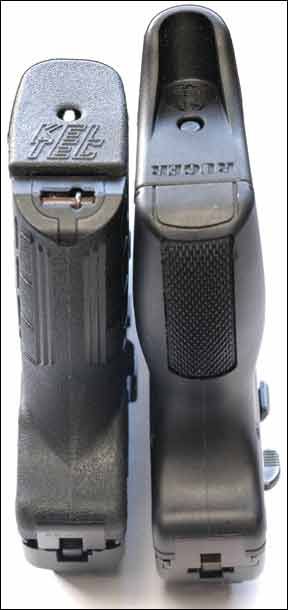
weight. There were more steel parts on the Ruger, like the sights and the trigger. Also the slide was not relieved at the front like the PF-9 was. The Ruger’s slide was also thicker and a touch longer. The Ruger had a thumb safety, useful for right-handed persons but essentially inaccessible for lefties. It was not reversible. Of course, a lefty could treat the Ruger like a Kel-Tec and ignore the safety lever.
There was a flip-up loaded-round indicator, familiar to owners of Lugers. The gun came with one magazine but two floorplates, just like Kel-Tec’s treatment. Kel-Tec included a polymer carry box, and Ruger gave the owner a zippered pouch. As with all Rugers, the matte-blued finish was excellent. The slide and barrel are blued alloy steel, not stainless. The frame is polymer, and its lone magazine was made in Italy, just like that of the Kel-Tec, and just like those for the 380 versions by each company.
The LC9’s frame is contoured significantly. When viewed from the back, the Ruger has a pronounced swell to its grip. The side contours are similar to those of the Kel-Tec, but in the case of the Ruger the cutout in the side of the frame put our firing-hand thumb into a position in which it interfered with the operation of the trigger. The Ruger’s trigger pull was nearly identically as long as that of the K-T, but Ruger extended the trigger guard forward to give more room to insert the index finger. The Ruger’s pull was a good deal stiffer than that of the Kel-Tec. It took more than 4 pounds to get the uncocked Ruger’s trigger all the way to the back of the guard. It took about 2 pounds to do the same with the Kel-Tec. But it got worse. The Ruger’s actual trigger pull stacked and stacked, but the Kel-Tec’s trigger seemed to go over center, with the final pull not requiring any more force than that required to get to the halfway point.
The three-white-dot steel sights of the Ruger gave a decent sight picture, with good width to the rear notch. The Ruger’s rear sight was drift adjustable, and locked by an Allen screw. The steel front sight was in to stay, nicely dovetailed, contoured to the slide, and vertically pinned by a small roll pin. It stuck up twice as high as the K-T’s front sight, making the gun that much harder to get out
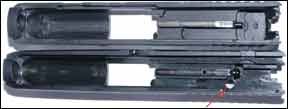
of a pocket. We thought the Kel-Tec’s front sight was adequately high, much better that the nearly invisible sights on the two companies’ 380s.
Ruger has reduced the necessary return travel of its copy of the Kel-Tec by about an eighth of an inch. The LC9’s pull measured 7.4 pounds, compared to 5 pounds for the PF-9. Ruger also has added what some of us think is a felony by adding a magazine disconnect. You can’t fire the Ruger with the magazine more than half an inch out of the gun. Some of us think Ruger gave too much attention to safety features and not enough to making the new gun really useful with a decent trigger and the ability to fire with the mag removed.
Ruger did change the takedown procedure with an eye toward easier disassembly. To take the Ruger apart you first clear it, and remove the magazine. Then press downward on a tiny door on the left side of the frame, just above the trigger. This reveals a pin, which you have to shove out with a sharp object from the other side, once you align the slide cutout with the pin. Then the slide

0)]goes off the front, just like the K-T. The cross pin is simple, and if lost, a replacement could be easily made. It’s less complex than the pin on the Kel-Tec, but is smaller and thus more easily lost. The Ruger system does simplify reassembly, though.
On the range we had one failure to eject with the Ruger, not repeated. The fired case was half-way out of the chamber, and the slide had gone all the way back and was resting on the next round in the magazine, a complete jam. The solution was to lock the slide back, extract the magazine, remove the empty—it fell out—and start over. The finger extension on the magazine could come in handy if the magazine stuck in the gun for any reason. Ruger had slightly beveled the mag opening, something that Kel-Tec needs to do. We all thought the Ruger was the more comfortable gun to shoot, but we all thought it had much the poorer trigger, and was slower to shoot rapid fire.
Our Team Said: Ruger has created a nice handgun in the LC9. The styling alone will sell a lot of guns. We think a lot of shooters will buy it largely because of the integrity of the Ruger name. Because of the very nice cosmetic treatment by Ruger, we believe many will overlook the fact that it weighs 2.5 ounces more and costs $110 more than the original design by Kel-Tec. Some will like the safety, though probably not any lefties. Many will prefer its steel sights over the rival’s plastic ones. The flip-

1)]top loaded-round indicator lets you know the gun’s condition in the dark, and some will like that. In short, the new Ruger did what Kel-Tec designed it to do, but didn’t do it as well as Kel-Tec, in our opinion. We gave the Ruger a C because it’s heavier, thicker, harder to shoot well, and a third-again more costly than the other gun.
More broadly, we noted that the slides didn’t interchange this time, as the 380s did, nor did the magazines. Yet it was clear from the identical overall look, inside and out, that Ruger looked at Kel-Tec’s ideas very closely. We wish Ruger had come up with its own fresh design instead of “me-tooing” one from Kel-Tec again. One of our readers made the comment on the earlier story that Ruger may no longer have a design department, and instead has adopted the process of simply copying other successful designs, with suitable upgrades or cosmetic alterations. While that is almost certainly not the case, we would love to see fresh, new innovative handgun designs from Ruger that aren’t such close renditions of other makers’ guns. Of course, we might someday see Kel-Tec bringing out some close copies of successful Ruger handguns. We think that’d be fair.
0411-COMPACT-9MM-ACC-CHRONO.pdf



























